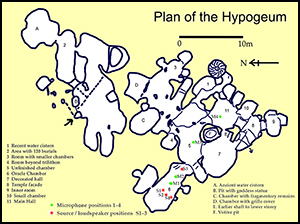Crossref Citations
This article has been cited by the following publications. This list is generated based on data provided by
Crossref.
Yioutsos, Nektarios-Petros
2019.
Between Worlds.
p.
113.
Till, Rupert
2019.
Sound Archaeology: A Study of the Acoustics of Three World Heritage Sites, Spanish Prehistoric Painted Caves, Stonehenge, and Paphos Theatre.
Acoustics,
Vol. 1,
Issue. 3,
p.
661.
Wolfe, Kristina
Swanson, Douglas
and
Till, Rupert
2020.
The frequency spectrum and geometry of the Ħal Saflieni Hypogeum appear tuned.
Journal of Archaeological Science: Reports,
Vol. 34,
Issue. ,
p.
102623.
Wilmering, Thomas
Moffat, David
Milo, Alessia
and
Sandler, Mark B.
2020.
A History of Audio Effects.
Applied Sciences,
Vol. 10,
Issue. 3,
p.
791.
Valenzuela, Jose
Díaz-Andreu, Margarita
and
Escera, Carles
2020.
Psychology Meets Archaeology: Psychoarchaeoacoustics for Understanding Ancient Minds and Their Relationship to the Sacred.
Frontiers in Psychology,
Vol. 11,
Issue. ,
Barbara, Jonathan
Grech, Jeremy
Camilleri, Joseph
McGurk, Silvio
and
Theuma, Charles
2021.
Digital Heritage. Progress in Cultural Heritage: Documentation, Preservation, and Protection.
Vol. 12642,
Issue. ,
p.
703.
S. Umbarkar, Ajinkya
V. Nandanwar, Deoram
and
P. Chimankar, Omprakash
2022.
Preliminary Archaeoacoustic Study of Kanheri Caves in Mumbai (Maharashtra, India).
Sound&Vibration,
Vol. 56,
Issue. 2,
p.
193.
Barratt, R.P.
2022.
Simulating a stone roof for the Maltese Neolithic temples: Analysing stress to understand specialisation.
Digital Applications in Archaeology and Cultural Heritage,
Vol. 27,
Issue. ,
p.
e00236.
Barbara, Jonathan
2022.
Re-Live History: An immersive virtual reality learning experience of prehistoric intangible cultural heritage.
Frontiers in Education,
Vol. 7,
Issue. ,
Navas-Reascos, Gustavo
Naal-Ruiz, Norberto E.
Alonso-Valerdi, Luz María
and
Ibarra-Zarate, David I.
2023.
Acoustic measurements of Edzna: A Mayan archaeological place in Mexico.
Journal of Archaeological Science: Reports,
Vol. 52,
Issue. ,
p.
104269.
Till, Rupert
2023.
Presenting Archaeoacoustics Results Using Multimedia and VR Technologies.
Open Archaeology,
Vol. 9,
Issue. 1,
Navas-Reascos, Gustavo
Wilhelm-deAlba, Guillermo
Alonso-Valerdi, Luz María
and
Ibarra-Zarate, David I.
2023.
Acoustic Characterization of Edzna: A Measurement Dataset.
Scientific Data,
Vol. 10,
Issue. 1,
Rainio, Riitta
and
Hytönen-Ng, Elina
2023.
Ringing Tone and Drumming Sages in the Crevice Cave of Pirunkirkko, Koli, Finland.
Open Archaeology,
Vol. 9,
Issue. 1,
Navas-Reascos, Gustavo
Alonso-Valerdi, Luz M.
and
Ibarra-Zarate, David I.
2023.
Archaeoacoustics around the World: A Literature Review (2016–2022).
Applied Sciences,
Vol. 13,
Issue. 4,
p.
2361.





